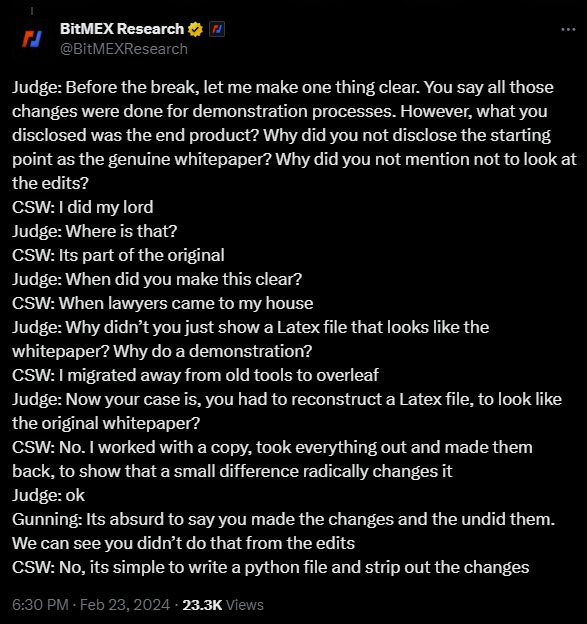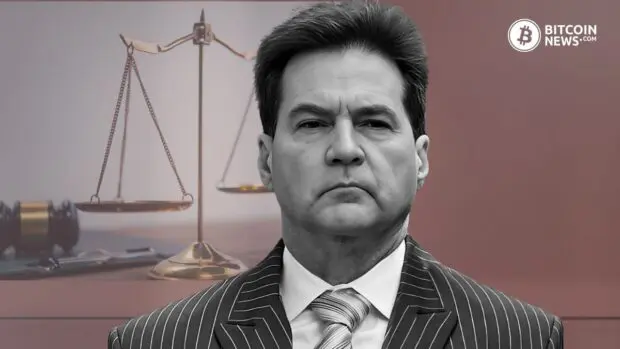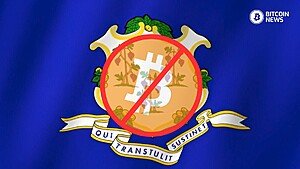In a courtroom drama that has captivated the Bitcoin community, Craig Steven Wright (CSW), the Australian computer scientist who claims to be Satoshi Nakamoto, the pseudonymous creator of Bitcoin, has found himself at the center of controversy. Craig Wright’s admission to editing the Bitcoin whitepaper documents submitted in legal proceedings against the Cryptocurrency Open Patent Alliance (COPA) has sparked heated debate and raised questions about the authenticity of his claims.
Craig Wright’s Admission of Edits
Wright’s confession came during a tense cross-examination in the ongoing trial between him and COPA. Alexander Gunning, representing Bitcoin developers, highlighted modifications Wright had made to the documents, specifically within “LaTeX files,” a document preparation system used for technical and scientific documentation.

Wright admitted to these edits, explaining that they were made for demonstration purposes to his legal team at Shoosmiths.
Debate Over Authenticity
The revelation of Wright’s document modifications has ignited controversy, with Gunning challenging the purpose behind these edits. He suggested that the changes were self-serving attempts to align the documents more closely with the original Bitcoin whitepaper rather than for mere demonstration purposes. Gunning’s assertion was backed by evidence showing that the file had been modified as recently as November 2023, casting doubt on the authenticity of Wright’s submissions.
Challenging Wright’s Claim
The cross-examination further delved into the legitimacy of Wright’s claim to the identity of Satoshi Nakamoto. Gunning directly questioned Wright’s assertions, suggesting that the edits were part of a larger effort to manipulate the evidence. Despite the challenges, Wright maintained his stance under further examination, denying any wrongdoing and reaffirming his claim to being the elusive Bitcoin creator.
Gunning: If you were forging the whitepaper that is how you would do it, isn’t it ?
CSW: Yes
Gunning: And you did it in Nov 2023?
CSW: I already have the originals that were shown to my legal team.
Gunning: Here is a sheet I prepared myself, with the custom parameters you created in the Latex file. You first increased the spacing size, then reduced it and then reduced it again. Then a minor tweak upwards.
CSW: Yes, this was part of the demonstration to Shoosmiths.
Gunning: This was not in the demonstration to Shoosmiths.
CSW: Well I was documenting it. I took screenshots.
Gunning: You took screenshots of each step?
CSW: Not all of them.
Gunning: The shrinking parameter, starts at 0.1, then you went to 0.3, before reducing, then increasing, then reducing to 0.16. Why?
CSW: I was showing that many changes can result in a tweak.
Gunning: You were not showing this to anyone.
CSW: I was showing to my lawyers.
Gunning: What you are doing is trying to fit the whitepaper.
CSW: I demonstrated how there changes work.
Contradictory Testimonies
Testimonies presented during the trial have challenged Wright‘s narrative. Computer scientist Marti Malmi provided critical counterpoints, contesting Wright’s timeline of interactions with Nakamoto. Malmi clarified that contrary to Wright’s assertion of being approached in February 2009, their actual communication took place on May 1, 2009. This contradiction, supported by released emails, undermines Wright’s credibility and adds complexity to the trial.
Implications for the Bitcoin Community
The trial’s outcome holds significant implications for the Bitcoin world. As the proceedings continue, the implications of Wright’s admissions and the testimonies presented will likely shape future discussions and decisions within the Bitcoin community.
Craig Wright’s admission to editing the Bitcoin whitepaper documents has injected new drama into the ongoing legal battle with COPA. The revelation, coupled with contradictory testimonies and evidence, underscores the complexities and challenges of establishing the true identity of Satoshi Nakamoto. As the trial progresses, it remains to be seen how the Bitcoin community will interpret and respond to these developments, which could have lasting repercussions for the future of Bitcoin and blockchain technology.










